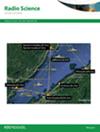Application of wide-beam transmission for advanced operations of SuperDARN Borealis radars in monostatic and multistatic modes
IF 1.6
4区 地球科学
Q3 ASTRONOMY & ASTROPHYSICS
引用次数: 0
Abstract
The Super Dual Auroral Radar Network (SuperDARN) consists of more than 30 monostatic high-frequency (HF, 8-20 MHz) radars to study dynamic processes in the ionosphere. SuperDARN provides maps of global-scale ionospheric plasma drift circulation from the mid-latitudes to the poles. The conventional SuperDARN radars consecutively scan through 16 beam directions with a lower limit of 1 minute to sample the entire field of view. In this work, we use the advanced capabilities of the recently developed Borealis digital SuperDARN radar system. Combining a wide transmission beam with multiple narrow reception beams allows us to sample all conventional beam directions simultaneously and to speed up scanning of the entire field-of-view by up to 16 times without noticeable deterioration of the data quality. The wide-beam emission also enabled the implementation of multistatic operations, where ionospheric scatter signals from one radar are received by other radars with overlapping viewing areas. These novel operations required the development of a new model to determine the geographic location of the source of the multistatic radar echoes. Our preliminary studies showed that, in comparison with the conventional monostatic operations, the multistatic operations provide a significant increase in geographic coverage, in some cases nearly doubling it. The multistatic data also provide additional velocity vector components, increasing the likelihood of reconstructing full plasma drift velocity vectors. The developed operational modes can be readily implemented at other fully digital SuperDARN radars.应用宽波束传输实现单静态和多静态模式下超级雷达网北极光雷达的高级操作
超级双极光雷达网(SuperDARN)由 30 多个单静态高频(HF,8-20 兆赫)雷达组成,用于研究电离层的动态过程。SuperDARN 提供从中纬度到两极的全球尺度电离层等离子体漂移环流图。传统的 SuperDARN 雷达连续扫描 16 个波束方向,整个视场的采样时间下限为 1 分钟。在这项工作中,我们使用了最近开发的 Borealis 数字超级雷达网雷达系统的先进功能。宽发射波束与多个窄接收波束相结合,使我们能够同时对所有常规波束方向进行采样,并将整个视场的扫描速度提高了 16 倍,而数据质量却没有明显下降。宽波束发射还使多静态操作成为可能,在多静态操作中,一台雷达发出的电离层散射信号会被视场重叠的其他雷达接收。这些新的操作要求开发一种新的模型,以确定多静态雷达回波源的地理位置。我们的初步研究表明,与传统的单静态操作相比,多静态操作的地理覆盖范围显著扩大,在某些情况下几乎翻了一番。多静态数据还提供了额外的速度矢量分量,增加了重建完整等离子体漂移速度矢量的可能性。所开发的运行模式可随时在其他全数字超级雷达网雷达上实施。
本文章由计算机程序翻译,如有差异,请以英文原文为准。
求助全文
约1分钟内获得全文
求助全文
来源期刊

Radio Science
工程技术-地球化学与地球物理
CiteScore
3.30
自引率
12.50%
发文量
112
审稿时长
1 months
期刊介绍:
Radio Science (RDS) publishes original scientific contributions on radio-frequency electromagnetic-propagation and its applications. Contributions covering measurement, modelling, prediction and forecasting techniques pertinent to fields and waves - including antennas, signals and systems, the terrestrial and space environment and radio propagation problems in radio astronomy - are welcome. Contributions may address propagation through, interaction with, and remote sensing of structures, geophysical media, plasmas, and materials, as well as the application of radio frequency electromagnetic techniques to remote sensing of the Earth and other bodies in the solar system.
 求助内容:
求助内容: 应助结果提醒方式:
应助结果提醒方式:


